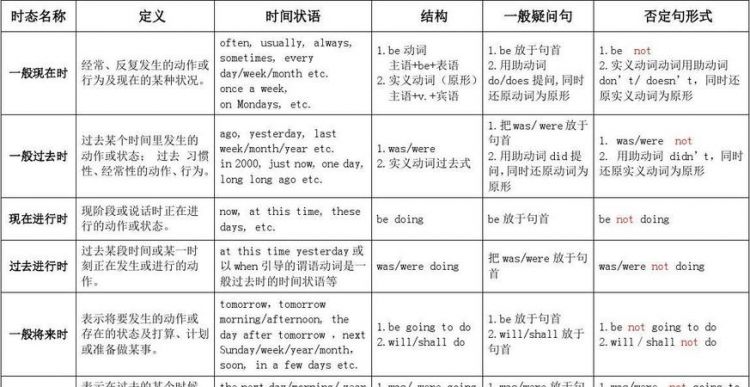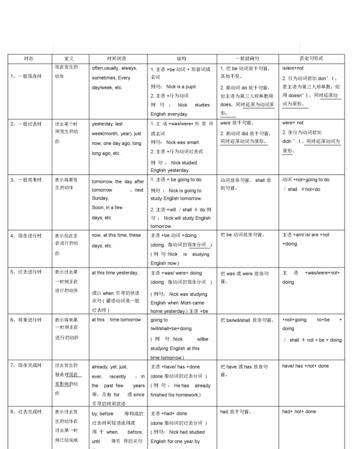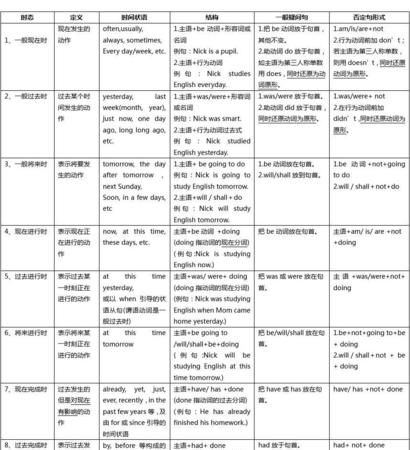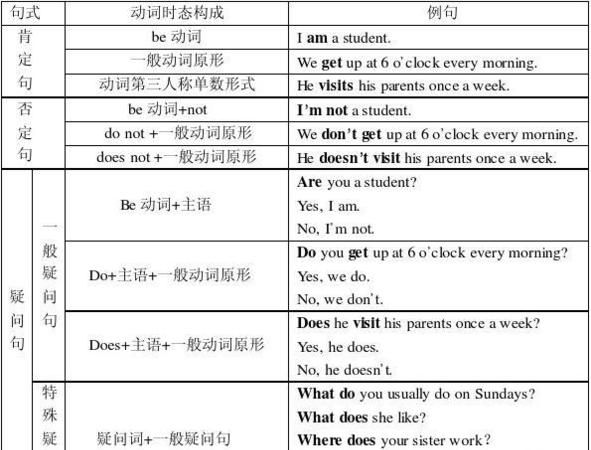本文目录
英语动词时态表
动词的时态:
英语的时态共有十六种,大纲要求的是如下八种时态:一般现在、现在进行、现在完成、一般过去、过去进行、过去完成、一般将来和过去将来。其中最常考到的是:现在完成、过去完成和一般过去时。其考点往往是时态的替代,并常与语态相结合。
英语动词时态表
时间状态
一般时进行时完成时完成进行时
现在do
doesam
doing
is
doing
are
doinghave
done
has
donehave
been
doing
has
been
doing
过去donewas
doing
were
doinghad
donehad
been
doing
将来shall
do
will
doshall
be
doing
will
be
doingshall
have
done
will
have
doneshall
have
been
doing
will
have
been
doing
过去将来should
do
would
doshould
be
doing
would
be
doingshould
have
done
would
have
doneshould
have
been
doing
would
have
been
doing

英语常用动词时态表
英语共有十六种时态,但平时比较常用的只有八种,如下:
一般现在时: 主语+do/does(现在分词)
e.g We clean the room every day.
2.一般过去时: 主语+did
e.g We cleaned the room just now.
3.现在进行时: 主语+am/is/are doing
e.g We are cleaning the room now.
4.过去进行时: was/were doing
e.g We were cheaning the room at 5:00 yesterday afternoon.
5.现在完成时: have/has done
e.g.We have cleaned the room already.
6.过去完成时: had done
e.g We had cleaned the room before he arrived.
7.一般将来时: will do/
e.g We will clean the room tomorrow.
8.过去将来时: was/were to /would do
e.g He said he would clean the room next.

初中英语时态表格
一、一般时态 1、一般现在时 (1)一般现在时表示没有时限的持久存在的动作或状态或现阶段反复发生的动作或状态,常和副词usually,often,always sometimes, regularly,near,occasionally,every year, every week等连用。例如: 1)The moon moves round the earth.. 2)Mr. Smith travels to work by bus every day. (2)在由after,until,before,once,when,even if,in case,as long as,as soon as,the moment以及if,unless等引导的时间状语从句或条件状语从句中,通常用一般现在时代替将来时。例如: 1)I will tell him the news as soon as I see him. 2)I will not go to countryside if it rains tomorrow. (3)某些表示起始的动词,可用一般现在时表示按规定、计划或安排要发生的动作,这类动词有:be,go,come,start,depart,arrive,begin,leave等。例如: 1)The plane leaves at three sharp. 2)The new teachers arrive tomorrow. (4)在由why,what,where,whoever,who,that,as等引导的从句中,也常用一般现在时代替将来时。例如: 1)Free tickets will be given to whoever comes first. 2)You’ll probably be in the same train as I am tomorrow. 2.一般过去时 (1)表示过去某一特定时间所发生的、可完成的动作或状态,常与表示确切过去时间的词、短语或从句连用。例如: We went to the pictures last night and saw a very interesting film. (2)表示过去习惯性动作。例如: 1)He always went to class last. 2)I used to do my homework in the library. (注意与be used to doing短语的区别) 3.一般将来时 1)表示将来打算进行或期待发生的动作或状态。例如: I shall graduate next year. 2)几种替代形式: 1)be going to +v在口语中广泛使用,表示准备做或将发生的事情。例如: I’m going to buy a house when we’ve saved enough money. 2)be to +v表示计划安排要做的事,具有“必要”的强制性意义。例如: I am to play tennis this afternoon. 3)be about to +v表示即将发生的事情。例如: He was about to start. 4)be due to +v表示预先确定了的事,必定发生的事。例如: The train is due to depart in ten minutes. 5)be on the point/verge of +v – ing强调即将发生的某种事态。例如: The baby was on the point of crying when her mother finally came home. 二、进行时态 1.现在进行时 (1)表示现在正在进行的动作,常与now,right now,at the mother,for the time being,for the present等连用。例如: Don’t disturb her. She is reading a newspaper now. (2)表示现阶段经常发生的动作,常与always,continually,forever,constantly等连用。例如: My father is forever criticizing me. (3)表示根据计划或安排在最近要进行的事情。具有这种语法功能的动词仅限于过渡性动词。即表示从一个状态或位置转移到另一个状态或位置上去的动词。常用的有:go,come,leave,start,arrive,return等。例如: They are leaving for Hong Kong next month. (4)有些动词不能用进行时,这是一类表示“感觉,感情,存在,从属”等的动词。如:see,hear,smell,taste,feel,notice,look,appear,(表示感觉的词);hate,love,fear,like,want,wish,prefer,refuse,forgive(表示感情的动词);be,exist,remain,stay,obtain(表示存在状态的动词);have,possess,own,contain,belong,consist of,form(表示占有与从属的动词);understand,know,believe,think,doubt,forget,remember(表示思考理解的动词)。但是如果它们词义改变,便也可用进行时态。例如: 1)Tom looks pale. What’s wrong with him? (look在此为联系动词,意为“显得,看上去”) 2)Tom is looking for his books. (look在此为实义动词,意为“寻找”) 2.过去进行时 过去进行时表示一个过去的动作发生时或发生后,另一个过去的动作正在进行,或表示过去反复的习惯,常与always,continually,constantly等动词连用。例如: 1)We were discussing the matter when the headmaster entered. 2)Whenever I visited him, he was always writing at the desk. 3.将来进行时 将来进行时主要表示将来某一时刻正在进行的动作,或表示要在将来某一时刻开始,并继续下去的动作。常用来表示礼貌的询问、请求等。例如: 1)This time next day they will be sitting in the cinema. 2)What will you be doing at six tomorrow evening? 4.完成进行时 (现在、过去、将来)完成进行时是(现在、过去、将来)完成时的强调形式,将放在完成时态部分讲述。 三、完成时态 完成时态通常表示已完成或从事的动作。它可分为: 1.现在完成时 (1)现在完成时用来表示对目前状况仍有影响的,刚刚完成的动作(常与yet,already,just连用),或者过去某一时刻发生的,持续到现在的情况(常与for,since连用)。例如: 1)I have just finished my homework. 2)Mary has been ill for three days. (2)常与现在完成时连用的时间状语有:since, for, during, over等引导出的短语;副词already, yet, just, ever, now, before, often, lately, recently等;状语词组this week (morning, month, year), so far, up to now, many times, up to the present等。例如: 1)I haven’t been there for five years. 2)So far, she hasn’t enjoyed the summer vacation. 3)There have been a lot of changes since 1978. (3)完成时态可用在下列结构中: This (That, It) is (was) the first (second…) time +定语从句;This (That, It) is (was) the only (last) + n +定语从句;This (That, It) is (was) +形容词最高级+ n +定语从句。如果主句的谓语动词是一般现在时,从句的谓语动词通常用现在完成时;如果主句谓语动词是一般过去时,从句谓语动词通常用过去完成时。例如: (1)This is one of the rarest questions that have ever been raised at such a meeting. (2)There was a knock at the door. It was the second time someone had interrupted me that evening. 2.过去完成时 (1)表示过去某时间前已经发生的动作或情况,这个过去的时间可以用by,before等介词短语或一个时间状语从句来表示;或者表示一个动作在另一个过去动作之前已经完成。例如: 1)We had just had our breakfast when Tom came in. 2)By the end of last year they had turned out 5, 000 bicycles. (2)动词expect, hope, mean, intend, plan, suppose, wish, want, desire等用过去完成时,表示过去的希望、预期、意图或愿望等没有实现。例如: I had meant to take a good holiday this year, but I wasn’t able to get away. 另外两种表示“过去想做而未做的事”的表达方式是: 1)was / were + to have done sth,例如: We were to have come yesterday, but we couldn’t. 2)intended (expected, hope, meant, planned, supposed, wished, wanted, desired) + to have done sth,例如: I meant to have told you about it, but I forgot to do so. (3)过去完成时常用于以下固定句型: 1)hardly, scarcely, barely + 过去完成时+ when + 过去时。例如: Hardly had I got on the bus when it started to move. 2)no sooner +过去完成时+ than +过去时。例如: No sooner had I gone out than he came to see me. 3)by (the end of ) +过去时间,主句中谓语动词用过去完成时。例如: The experiment had been finished by 4 o’clock yesterday afternoon. 3.将来完成时 将来完成时表示在将来某一时刻将完成或在另一个未来的动作发生之前已经完成的动作;也可以用来表示一种猜测。常与将来完成时连用的时间状语有:by (the time / the end of ) +表示将来时间的短语和句子;before (the end of ) +表示将来时间的词语或句子;when, after等加上表示将来动作的句子等。例如: 1)By this time tomorrow you will have arrived in Shanghai. 2)I shall have finished this composition before 9 o’clock. 3)When we get on the railway station, the train will probably have left. 4.完成进行时 完成进行时是完成时的强调形式,有现在完成进行时,过去完成进行时,将来完成进行时。 (1)现在完成进行时表示过去某一时刻之前开始的动作或状态一直延续到过去某一时刻。例如: I have been looking for my lost book for three days, but I still haven’t found it. (2)过去完成进行时表示过去某一时刻之前开始的动作或状态一直延续到过去某一时刻。例如: It had been raining cats and dogs for over a week and the downpour had caused landslides in many places. (3)将来完成进行时表示在将来某一时刻之前开始的一个动作或状态一直延续到将来某一时刻。例如: By the time you arrive tonight, she will have been typing for hours. 四:时态一致 时态一致是英语四、六级考试的一个重要内容。通常应由主句谓语的时态决定从句的谓语时态。一般原则是: 1、当主句谓语使用现在时或将来时,从句的谓语根据具体情况使用任何时态 He says that he lives in Wuhan. We hope that there will be many people at your party today. “Did you hear that Bill finally sold the house?” “Yes, but I don’t know who bought it.” “There’s a lot of excitement on the street.” “There certainly is. Do you suppose the astronauts have returned?” 2、当主句谓语使用过去时的时候,从句的谓语必须使用过去范围的时态 He said he was writing a novel. The teacher wanted to know when we would finish the experiment. He said his father had been an engineer. 3、当从句是表示没有时间概念的真理时,从句的谓语应使用一般现在时。例如: The teacher told them since light travels faster than sound, lightning appears to go before thunder. 注:在此种情况下,即使主句谓语用了过去式的各种时态,从句谓语也应用一般现在时。 4、从句谓语只能用虚拟语气的情况 利用时态一致原则确定从句动词时态时,还应注意,若主语动词是表示命令、请求、要求、建议、劝告等的动词,从句谓语只能用虚拟语气,不能遵循时态一致原则。例如: We insisted that we do it ourselves. 动词的语态 语态也是动词的一种形式,英语有两种语态:主动语态和被动语态。主动语态表示主语是动作的执行者,而被动语态表示主语是动作的承受者。 1)We use electricity to run machines. (主动语态) 2)Electricity is used to run machines. (被动语态) 1.不能用于被动语态的动词和短语 (1)在英语中,不及物动词不能用于被动语态,但有些不及物动词(包括短语)容易引起误用。如:appear, belong, belong, die, escape, fall, happen, last, remain, succeed, occur, come true, take place, consist of。 (2)某些表示状态或特征的及物动词,如:become, contain, cost, fit, have, resemble, suit也没有被动语态。 2.被动语态的时态形式 常用的被动语态有表1所列的几种时态形式。 表1 时?SPAN lang=EN-US> 一般时进行时完成时 现在 am asked am being asked is asked is being asked are asked are being asked 过去 was be asked was being asked were be asked were being asked 将来 shall be asked shall have been asked will be asked will have been asked 过去 should be asked should have been asked 将来 would be asked would have been asked 3.短语动词的被动语态 短语动词转换为被动语态时,通常被看作是一个动词,后面的介词或副词不能拆开或省略。例如: 1)So far no correct conclusion has arrived at. 2)All the rubbish should be got rid of. 4.“get + -ed分词”的被动语态 “get + -ed分词”结构强调动作的结果,而非动作本身,常用来表示突发性的,出乎意料的偶然事件。例如: The boy got hurt on his way home from work. 另外,“get + -ed分词”还可用于谈论为自己做的事,是主动的行为而不是被动的行为。例如: get dressed(穿衣服) get divorced(离婚) get engaged(订婚) get confused(迷惑不解) get lost(迷路) get washed(洗脸) get married(结婚) 5.能带两个宾语和复合宾语的动词改为被动语态 (1)能带两个宾语的动词改为被动语态时,一次只能由一个宾语作主语,另一个宾语被保留下来。例如: 1)We showed the visitors our new products.(主动语态) 2)The visitors were shown our new products.(被动语态) 3)Our new products were shown to the visitors.(被动语态) (2)能带复合宾语的动词改为被动语态时,原来的宾语补足语变为主语补足语。例如: 1)The teacher appointed him League secretary.(主动语态) 2)He was appointed League secretary.(被动语态) 6.被动语态与系表结构的区别 (1)The novel was well written.(系表结构) (2)The novel was written by Diskens.(被动语态) 7.少数动词的主动语态有时有被动的意思 例1:The book is selling remarkably well. 例2:The song sounds very beautiful. 能这样用的动词还有read(读起来),clean(擦起来),wash(洗起来),write(写起来)。 例3:My watch needs cleaning. (= My watch needs to be cleaned). 能像need这样用的动词还有:want, require, deserve, do, owe, bind等。 例4:The meat is cooking. 例5:The book written by the professor is printing.

英语常用动词时态表
动词的时态:
英语的时态共有十六种,大纲要求的是如下八种时态:一般现在、现在进行、现在完成、一般过去、过去进行、过去完成、一般将来和过去将来.其中最常考到的是:现在完成、过去完成和一般过去时.其考点往往是时态的替代,并常与语态相结合.
英语动词时态表
时间状态 一般时进行时完成时完成进行时
现在do
doesam doing
is doing
are doinghave done
has donehave been doing
has been doing
过去donewas doing
were doinghad donehad been doing
将来shall do
will doshall be doing
will be doingshall have done
will have doneshall have been doing
will have been doing
过去将来should do
would doshould be doing
would be doingshould have done
would have doneshould have been doing
would have been doing

以上就是关于初三英语动词时态表格 ,英语动词时态表的全部内容,以及初三英语动词时态表格 的相关内容,希望能够帮到您。

